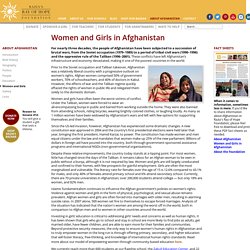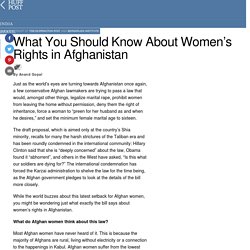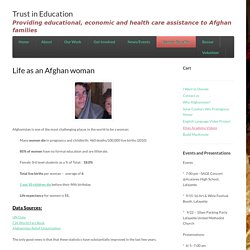

Women in Afghanistan: the back story. Afghanistan has a tumultuous recent past.

In the last three decades, the country has been occupied by communist Soviet troops and US-led international forces, and in the years in between has been ruled by militant groups and the infamous oppressive Islamic Taliban. Throughout the changing political landscape of Afghanistan in the last fifty years, women's rights have been exploited by different groups for political gain, sometimes being improved but often being abused. 'Afghan women were the ones who lost most from the war and militarisation.'Horia Mosadiq Horia Mosadiq was a young girl when Russia invaded Afghanistan in 1979.
Before the 1979 invasion Think of women in Afghanistan now, and you'll probably recall pictures in the media of women in full-body burqas, perhaps the famous National Geographic photograph of 'the Afghan girl', or prominent figures murdered for visibly defending women's rights. 'As a girl, I remember my mother wearing miniskirts and taking us to the cinema. Afghan women's rights: Global Journalist. Women’s rights and opportunities have improved in Afghanistan over the past 15 years after the ouster of the Taliban.

They’re no longer required to wear the burqa and are again allowed to attend school and leave the house without a male relative. But as several recent incidents have highlighted, women in the country still face high levels of violence – including honor killings, forced marriages and and imprisonment for fleeing their husbands. On this edition of Global Journalist, our panel examines the challenges and opportunities for women in Afghanistan.
In addition, a bestselling author discusses the longstanding practice of families without sons dressing and raising their daughters as boys, a phenomenon known as “bacha posh.” Women and Girls in Afghanistan — Razia's Ray of Hope. For nearly three decades, the people of Afghanistan have been subjected to a succession of brutal wars, from the Soviet occupation (1979–1989) to a period of tribal civil wars (1990–1996) and the oppressive rule of the Taliban (1996–2001).

These conflicts have left Afghanistan’s infrastructure and economy devastated, making it one of the poorest countries in the world. Prior to the Soviet occupation and Taliban takeover, Afghanistan was a relatively liberal country with a progressive outlook on women’s rights. Afghan women comprised 50% of government workers, 70% of schoolteachers, and 40% of doctors in Kabul.
However, the effects of war and the Taliban regime quickly effaced the rights of women in public life and relegated them solely to the domestic domain. Women and girls have often been the worst victims of conflict. Since the US-led invasion, however, Afghanistan has experienced some dramatic changes. Despite these relative improvements, the country today stands at a tipping point. Women in Afghanistan. Women for Women International. Women care for 3 children on average Average daily income is $0.00 at enrollment 87% have no formal education Decades of violence in Afghanistan have left millions of women and girls displaced or widowed.

Common discriminatory practices, amplified by extremist groups, often make it dangerous for women to seek education, healthcare services, employment, or, in some cases, even to leave their homes. Women like Zarghuna have not lost hope. Our Impact. Women's Rights in Afghanistan. Just as the world’s eyes are turning towards Afghanistan once again, a few conservative Afghan lawmakers are trying to pass a law that would, amongst other things, legalize marital rape, prohibit women from leaving the home without permission, deny them the right of inheritance, force a woman to “preen for her husband as and when he desires,” and set the minimum female marital age to sixteen.

The draft proposal, which is aimed only at the country’s Shia minority, recalls for many the harsh strictures of the Taliban era and has been roundly condemned in the international community: Hillary Clinton said that she is “deeply concerned” about the law, Obama found it “abhorrent”, and others in the West have asked, “Is this what our soldiers are dying for?” Life as an Afghan woman - Trust in Education. Afghanistan is one of the most challenging places in the world to be a woman: Many women die in pregnancy and childbirth: 460 deaths/100,000 live births (2010) 85% of women have no formal education and are illiterate.

Female 3rd level students as a % of Total: 18.0% Total live births per woman – average of 6 1 out 10 children die before their fifth birthday. Life expectancy for women is 51. Data Sources: UN DataCIA World Fact Book Afghanistan Relief Organization.